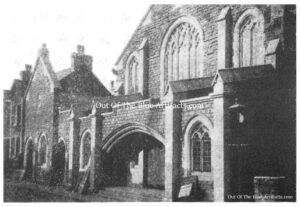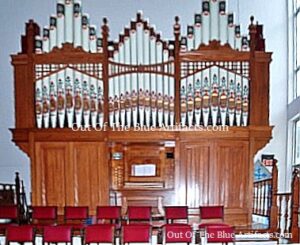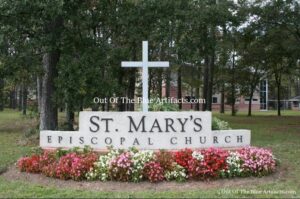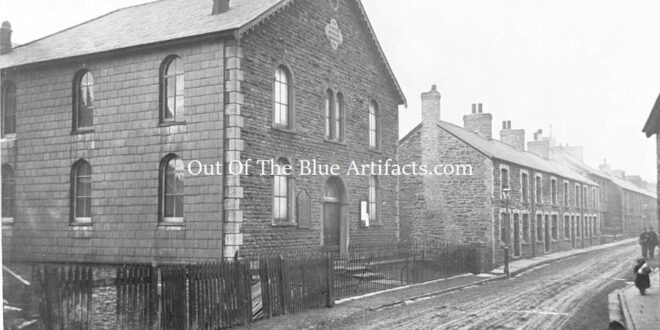Cwm Street Primitive Methodist Tabernacle Chapel – Abertillery.
Mr Charles Saunders.
The Methodist Movement at Abertillery was said to have begun in 1847 at the house of Mr Charles Saunders at the Kings Head, Abertillery.
Mr Thomas Preece.
Mr Thomas Preece was invited to preach at Abertillery and was later persuaded to come to this district to reside. At this time, it was decided to make an application to the Aberdare circuit to secure preachers and ministers and for the following two years services were held at Pant-yr-Arral Farm and Cottage, Six Bells, Abertillery. It was found that many would not attend the indoor services, so Mr Preece with the other preachers resorted to open-air services and Mrs Preece would often help her husband with the preaching.
The Sunday School.
In 1849 Sunday School was organised and held at the home of Mr Thomas Preece at Cwmnant-y-Groes and conducted every Sunday morning.
The Building of a Chapel.
Owing to the increasing population at this time it was decided to build a Methodist Chapel, the chapel was built on a site where Lower Castle Street, Abertillery, is today and was said to have cost £200, equivalent to £24,000 in today’s money.
Services were held at the chapel by the following clergymen – Rev J. Warnes; C. Saunders; G. Summers; T. Preece and Rev G. Watts:
The information on the history of the Methodist Movement and early Methodist Chapel above – (Source – South Wales Gazette, Friday 9th of July 1915).
Mr Thomas Preece and Mr Charles Saunders were not found on early censuses, they only seemed to appear at Abertillery in the late 1860’s and both featured on the 1871 census.
On that 1871 census Mr Charles Saunders, his wife and family lived at the Primitive Methodist Chapel House, Castle Street and Mr Thomas Preece lived at Tyr Watkin Farm, Abertillery with his mother Mrs Ann Edwards and stepfather Mr William Edwards, farmers.
New Church Constructed in 1876.
In 1876 the church moved from Lower Castle Street to Cwm Street, Abertillery with Rev Jabez Oliver. The new chapel was constructed at Cwm Street, Abertillery (as seen in the main featured image above). There are no known reports of the official or formal opening of the new Primitive Methodist Chapel though it was known as the Cwm Street Primitive Methodist Tabernacle Chapel.
In December 1876 a concert was held at the Castle Inn, Abertillery in aid of the new Primitive Methodist Tabernacle Chapel at Cwm Street, Abertillery.
New Classrooms at the Chapel.
In 1893 two new classrooms were added to the chapel at a cost of £200, these afforded room for an extra 100 scholars.
Cwm Street Name Change.
Cwm Street was the stretch of road from the Pontlottyn Store to the top of Alexandra Road, where the Cwm Hotel would later be built. It was named Cwm Street after the Cwm Estate whose land it was constructed upon.
 In June 1895 the Abertillery District Council officially renamed Cwm Street as Somerset Street, Abertillery (as seen in the newspaper clipping left). I believe that Cwm Street still existed though only a small section of the street from the police station to the war memorial. From this point the Cwm Street Primitive Methodist Tabernacle Chapel was now located on Somerset Street and would be known as the Somerset Street Primitive Methodist Tabernacle Chapel though still called Cwm Street Methodists and reported as such by many locals and reporters.
In June 1895 the Abertillery District Council officially renamed Cwm Street as Somerset Street, Abertillery (as seen in the newspaper clipping left). I believe that Cwm Street still existed though only a small section of the street from the police station to the war memorial. From this point the Cwm Street Primitive Methodist Tabernacle Chapel was now located on Somerset Street and would be known as the Somerset Street Primitive Methodist Tabernacle Chapel though still called Cwm Street Methodists and reported as such by many locals and reporters.
New Side Galleries.
In 1896 new side galleries were added to the Somerset Street Methodists Chapel at a cost of £700.
Newhall Street Chapel.
In July 1906 Newall Street Chapel was built as a sister chapel to the Primitive Methodist Tabernacle Chapel, Somerset Street.
The Renovations.
On Sunday 4th of October 1903, the Somerset Street Primitive Methodist Tabernacle Chapel reopened after extensive renovations. The chapel had been fully redecorated by Mr Harris of Vivian Street, Abertillery. The superintendent minister was Mr E. Ball. Later songs were rendered by Miss Gladys Brown. A Bible and hymnal were presented to the chapel by Mr Joseph Parry Ovens of Carlyle Street, Abertillery.
The Anniversary Service.
On Sunday 1st of November 1903, the annual service in connection with the Primitive Methodist Chapel Sunday School, Somerset Street, Abertillery took place. Rev J. Whittock of Tonypandy, formerly of Abertillery took to the pulpit. In the afternoon and evening appropriate addresses and services were held and also a programme of solos and recitations given by the following – Misses S. A. Brown; L. West; H. Edwards; G. Day; J. Padfield; E. Smith; B. Ovens; A. Williams; S. E. Richards and Checkley; J. Hutchins and F. Perry: Anthems and hymns were given by the choir under the conductorship of Mr T. Preece, accompanied by Mr E. Hancock. On the following Monday a public meeting was held and presided over by Mr Mark Ashley and addresses were given by Rev J. Whittock; Messrs S. Dando and F. Padfield:
The New Pipe Organ.
On Wednesday 4th of November 1903, a grand organ recital was given at the Primitive Methodist Chapel, Somerset Street, Abertillery on the occasion of the opening of a new organ that had been erected by Messrs Vowles of Bristol. The new organ cost £330, the old instrument was said to have been taken by the firm in part payment.
In July 1905 Mr Moses Adams the contractor of Abertillery built two cottages in the grounds of the chapel, one was constructed for the vicar’s residence. The architect was Mr William Tarrant.
A New Sunday School Building Proposal.
January 1912 proposed larger Sunday School premises. The building was proposed and planning went ahead, though it took two years to accomplish.
 The New Chapel Frontage.
The New Chapel Frontage.
In October 1914 a new larger Sunday School building and a completely new frontage was proposed to be built onto the Somerset Street Primitive Methodist Chapel, Abertillery. At this time the name tabernacle became less used in the many reports in connection with the chapel on Somerset Street.
The Foundation Stone Laying Ceremony.
On Monday 21st of December 1914, the foundation stone laying ceremony was held in connection with the new Sunday School building and new frontage structure at the Somerset Street Primitive Methodist Chapel, Abertillery took place. Work had been ongoing for a few weeks making the Sunday School larger and it was stated that work on the new front structure would begin soon as the school had been completed.
The work consisted of the following – The ceiling of the church was raised by six-feet, the school below was lowered by two-feet with a raised gallery at the back with folding partitions to form two classrooms. The total cost of the alterations was £2,100. There were sixty-five foundation stones laid on behalf of various donors to the scheme, too many to write in this account though if anyone needs any details for family research please ask and I can provide a list.
The Belgian Refugees.
Apart from the many foundation stones, a center foundation stone bearing the inscription “To commemorate the visit of the Belgian refugees, some of whom found hospitality in the adjoining premises. Laid by M. Cornet, Liege, December 1914”. Mr Cornet responded and addressed the meeting in French, which was interpreted by the Rev F. P. Pearce. Mr Cornet spoke of the honour bestowed upon him by having laid the center stone in such a noble building, the purpose of the stone was to render immemorial the hearty reception accorded to his unhappy compatriots by the people of Abertillery and the members of the Primitive Methodist Chapel, Abertillery. He closed by saying “I address a hearty thanks from myself and all the Belgian refugees in this locality”.
The Closure of the Chapel.
I’m not sure when services ceased at the chapel though it was closed in the 1970’s and the building was used as a second-hand business selling antiques and such throughout the 1980’s.
 The Chapel Organ.
The Chapel Organ.
It was decided that the building interior had to be removed and salvaged, the large pipe-organ made by Messrs Vowles of Bristol in 1903 was removed intact, sold and shipped to the United States.
In 1986 the organ found its way to Huston, Texas and was given to St Mary’s Episcopal Church, Cyprus, Texas by Mr and Mrs Jim and Suzanne Kelly. The organ which had been transported to the U.S.A. in pieces was carefully restored by Mr and Mrs Roy and Sharon Redman and was installed at St Mary’s in 1992.
I have been in communication with Mr Roy Redman and he still maintains the organ and it is in constant use by the members of St Mary’s Church, Texas, U.S.A. The organ can be seen in the image (above) taken recently.
 The official name and address of the church that preserved the organ is as follows –
The official name and address of the church that preserved the organ is as follows –
St. Mary’s Episcopal Church,
15415 N. Eldridge Parkway,
Cypress,
Texas 77429.
The Demolition of the Somerset Street Primitive Methodist Chapel.
In April 1988 the Somerset Street Primitive Methodist Chapel, Somerset Street was demolished. The contractors for the demolition were McCarthy of Merthyr.
 Out Of The Blue Artifacts A Library of a lifetime of collecting
Out Of The Blue Artifacts A Library of a lifetime of collecting
